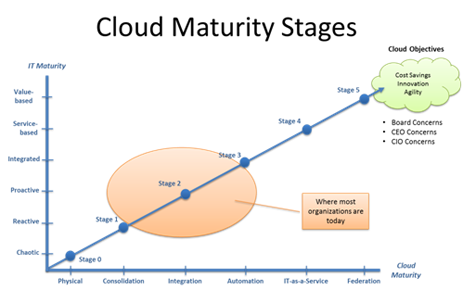
How Five Companies Transformed Their IT to Meet New Data Needs
Today’s enterprise companies are at a critical juncture. Faced with needing to manage ever-increasing volumes of data and applications, many have since decided to bite the bullet when it comes to transforming their IT infrastructures.
 Instead of limping along with ‘make-do’ patches to the same, inefficient legacy architectures, many companies are opting, instead, to modernize IT. But, what are the technologies and methods involved in this type of modernization? One hint: Many are natural building blocks on the road to cloud computing.
Instead of limping along with ‘make-do’ patches to the same, inefficient legacy architectures, many companies are opting, instead, to modernize IT. But, what are the technologies and methods involved in this type of modernization? One hint: Many are natural building blocks on the road to cloud computing.
Here, we’ll take a look at some of the technologies that have started to propel companies toward greater efficiency, greater agility and deeper cost savings. We’ll then share some examples of IT transformation success from five diverse companies.
Most Roads Lead to Cloud
Many companies’ ultimate vision for cloud can differ, as can their evolutionary speed and types of milestones reached along the way. Some may believe the best move is toward private clouds (those environments managed behind the company’s data center and firewall), while others might be more weighted toward IT acting as a broker of cloud services. In the latter sense, this might involve cloud services derived from within (a private cloud), from external providers (a public cloud) or from a hybrid mix of the two.
Regardless of the nuances involved, there tends to be a common evolutionary path enterprise organizations take toward cloud computing and IT modernization. This is shown in our five-stage cloud maturity model (as seen below).

Most enterprises seem to be at Stage 2 or the start of Stage 3. This means that they have begun to move from reactive to more proactive in their approach and in their choice of underlying technologies. They are also focusing more on automating tasks, such as the automated provisioning of pooled resources, and the development of IT as a service. The ultimate goal (at Stage 5) is optimal delivery of IT services and the ability to federate services in a hybrid style from multiple cloud models.
Each cloud maturity phase has its own set of business drivers, challenges and technologies. In the next segment, we’ll briefly describe a few of the most significant technology moves that have been used successfully to modernize many of our midrange and enterprise customer environments.
Cloud-enabling Technologies and Methodologies
Consolidation and virtualization have been–and still are–the early markers of the move to transform IT. In a new, cloud-centric world, however, such moves often evolve into a different form. Now, instead of just bringing disparate storage systems or servers together into a shared, networked environment, we have begun to see the emergence of technologies and practices around virtual data centers (VDCs), unified computing and converged networks.
VDCs extend virtualization beyond servers to also encompass virtualized networks and virtualized storage. While not required for a future private cloud environment, VDCs often act as an intermediate stage and a natural foundation for the building of subsequent private clouds. (Unfortunately, a full discourse on VDCs is not possible here.
The other key areas of technological breakthrough we’ve begun to see are referred to by a number of different names. These include unified computing, fabric-based infrastructures or converged infrastructures. What these terms refer to is heavily pre-integrated solutions (as well as pre-tested, pre-validated reference architectures) from multiple vendors. The result is a “unified” stack of compute, network and storage resources specifically tuned by vendors toward cloud-like operations. The benefits of these building blocks to cloud are numerous. They include the ability to reduce the systems’ on-going support and maintenance, as well as automating many tasks associated with resource provisioning and system management.
Five Companies and Their Real-World Results
We’ve mentioned consolidation, virtualization, VDCs and such concepts as unified computing. Some of them may sound interesting, but how do such transformation moves translate into a tangible benefit to the business and its needs to manage ever-changing volumes of data?
We’ll share a few glimpses of how five enterprise customers have put many of these technologies to work. These are good representative examples, as each customer represents a very different market sector.
- Leading healthcare company. One company represents one of the largest U.S. public healthcare systems. On a tight budget, the county hospital system needed to simultaneously watch its budget yet improve the way its services and information were delivered to its patients, its doctors, its clinics and its hospitals. As part of their modernization efforts, they opted to replace their legacy IT siloes with a unified, virtual data center and private cloud infrastructure.
Today, the organization is able to offer many innovative cloud services that have significantly improved doctor access to patient information and an improvement in overall patient experiences. This included a significant reduction in patient wait times. Thankful for its moves thus far to modernize IT, the hospital system fully expects to achieve a savings in the seven-figure range. In the next 3-5 years, the organization also anticipating achieving a 200% return on its cloud project investment.
- Large automotive industry retailer. One of the largest U.S. automotive retailers, this organization wanted to make its car-buying data and applications more mobile and accessible beyond the walls of its administrative offices. This included the ability to access it via iPad from either the showroom floor or out in one of its car lots. Similar to the success of Apple retail stores, the company hoped to foster easy access to vehicle information wherever the customer was.
Using many of the technologies already described, the retailer was able to develop IT cloud services to fit this need. End results of the project included increased revenue, shorter response times for customers, and faster delivery times. The company itself also had a change of heart about the role of its IT organization. Now, instead of considering it only a cost center, it became one of the company’s integral centers of innovation.
- Global network communications provider. The North American division of this network communications company wanted to speed deployment of new applications and servers, eliminate server sprawl and identify and replace inefficient IT siloes. After they implemented a unified computing architecture and virtual data center, the division was able to experience several efficiency gains. These included drastic drops in new server provisioning times, being reduced from a prior three weeks to now just 15 minutes. It also included the attainment of the division’s ROI goal for the project within the project’s first six months of operation.
- Higher education company. A globally recognized education industry leader, this organization needed an elastic cloud architecture that could successfully combine the disparate needs of its online and traditional learning environments across multiple continents. The organization also needed an economical, yet scalable infrastructure to address the significant ebb and flow of students’ digital workloads throughout the quarter. It also needed an environment that could handle the constant development and test efforts to push the online envelope with new educational applications.
The organization ultimately deployed a virtual data center and unified computing infrastructure. Thanks to the new environment, the company has been able to significantly reduce its power and cooling costs. It’s also decommissioned a large portion of physical servers. Now, instead of taking six weeks to deploy new application environments, the organization can do so in under six hours. The task also no longer requires the involvement and coordination with multiple teams. The company is also excited that its virtual workloads can now be easily shifted and moved to accommodate more on-demand needs.
- Mobile/wireless SaaS provider to the transportation and logistics industry. This company had to deal with 200% annual data center growth and a growing business model that required fast IT change to accommodate new opportunities and new customers. They also were able to deploy a virtual data center and unified computing infrastructure. As a result of this IT modernization project, the company has since been able to grow more dynamically to meet new demands. It’s also been able to offer better customer services with higher quality delivery of service. Even more important for its customers, the company was able to improve its services while lowering its own costs of doing business.
These use cases illustrate five very different sets of customer needs as well as very different customer outcomes. Yet, in most cases, they were able to use many of the same underpinning technologies to modernize their IT infrastructures. In the process, they were also able to evolve toward a more cloud-centric model of IT service delivery. Well-defined plans and anticipated deliverables paved the way to clear business value achieved from their own modernization efforts.
———————–
Kent Christensen is the virtual data center and cloud practice manager for Datalink (Eden Prairie, MN). For more information, see also Datalink whitepapers on moving to the cloud and the evolution of virtual data centers. More details on each use case deployment described here are also available upon request to Datalink.


























